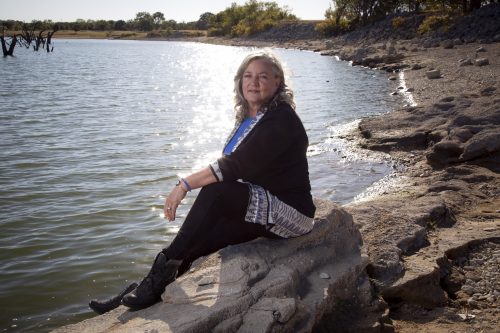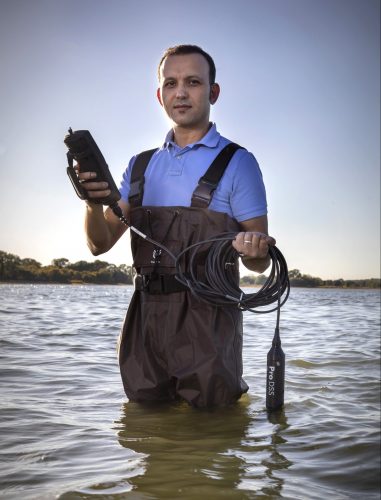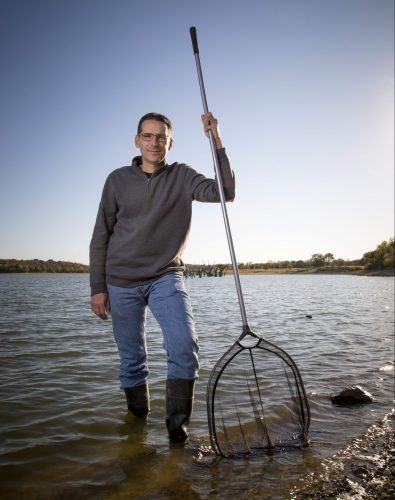
Marlo Jeffries uses genetically engineered Japanese rice fish to help identify sublethal chemical contaminants in water. Photo by Joyce Marshall
We’re Running Out of Fresh Water
TCU researchers focus on protecting our most precious resource.
Fire up your favorite mapping app, put it on satellite mode and take a virtual flight over the West. Have a look at Lake Mead, the United States’ biggest reservoir, buttoned in place by the mighty Hoover Dam. Head to western Kansas, where irrigated farms live by water pumped from an ancient aquifer, the Ogallala. Look for Fort Worth and see the Trinity River winding through downtown, then zoom out to farm and ranch country. Spot some of the hundreds of thousands of farm ponds that dot the Great Plains.
From high above, these waters look idyllic. But all of them are troubled.
Lake Mead is shrinking, its waters victim to drought, evaporation and heavy use by the 25 million Westerners it serves. The Ogallala refills so slowly that it will be effectively gone within the careers of many High Plains farmers.
Fort Worth experienced disastrous flooding in August 2022 when heavy rain battered Tarrant County. Drinking water in most cities is vulnerable to contamination by bacteria, microplastics and a host of chemicals, while nearby farm ponds accumulate toxic mercury.
Growing urban populations, climate change and water systems unprepared for precipitation extremes have placed the freshwater supply under alarming pressure in the American West and throughout the world.
As TCU professors study water challenges, they are equipping students to help secure access to safe, adequate water supplies far into the future. University researchers are devising ways to detect and control water pollution, designing water-smart structures for cities navigating climate change and ensuring students grasp their roles in safeguarding this precious resource.
“We take water for granted. We think it’s endlessly available,” said Chris Farley ’96 RM, assistant director of TCU’s ranch management program and Southwestern Exposition and Livestock Show professor. But, he added, “if we abuse it, we’re going to lose it.”
A Question of Scarcity
Earth contains 326 million cubic miles of water; only about half of 1 percent is fresh and accessible to humans. Faced with water scarcities, humans have reshaped rivers, drowned canyons to form reservoirs, drained aquifers and pumped water from the ground. Millions now live in heavily altered waterscapes with scant available natural supplies.
Will the water last, or will we run out?
Becky Johnson ’95 MS has spent a career grappling with questions of water quality and scarcity. A professor of professional practice in environmental science, she is a geoscientist and an expert in groundwater and water remediation.
She wants students to understand the stakes. She introduces them to the concept of net-zero water use — local water independence — as exemplified by the International Space Station and at demonstration buildings in the United States. What if cities could consume only what they can continually recycle?

Becky Johnson challenges students to consider the threat to clean, safe water. Farming practices and growing populations in arid parts of the country are draining the aquifers that supply fresh groundwater. Photo by Joyce Marshall.
Water and food are also in a complicated relationship. Irrigation has turned many dry Western regions into abundant farmland, but at a heavy cost to the water supply. In Texas, where many farmers raise thirsty crops like corn, rice and cotton, irrigation accounts for 30 percent of the state’s surface water use and 76 percent of its groundwater use. In California, vast amounts of power move water uphill to some farming regions.
Is rerouting that scarce resource sustainable? “Why are we growing crops in regions where the rainfall is not sufficient?” Johnson said. “That’s question No. 1 to me.”
Groundwater, which saturates subterranean sand and rock layers, constitutes the planet’s largest supply of fresh water, and underground aquifers are often clean and abundant. Some are quickly renewed by rains, like the porous Edwards Aquifer of south central Texas, whose daily levels appear on San Antonio newscasts.
But others contain irreplaceable fossil water. Case in point: The 175,000-square-mile Ogallala, which sweeps north-south from South Dakota to the Texas Panhandle, began to shrink around 1950, soon after farmers began tapping it for irrigation.
Most water pumped from underground never makes it back down, Johnson said. “It gets used by the crops, it evaporates, or it stays in the upper levels of the soil as soil moisture, and it never infiltrates all the way back down to recharge the aquifer.”
A dwindling aquifer leads to wells that run dry, land that slumps, and ecosystems and economies that falter, no longer fed by their hidden connections to groundwater.
“Not every place is going to be out of water that quickly,” Johnson said, “but certain regions that have been mining their aquifer for decades” — such as parts of Kansas and West Texas — “are in real danger now.”
Stopgap measures exist. Some farmers are adopting more efficient irrigation methods; farmers in dry regions can transition to less water-intensive crops like soy. Texas is dotted with over 100 desalination plants that create fresh water from brackish aquifers. Texas, Johnson said, does as much desalination as Saudi Arabia.
The state is also exploring the possibility of storing surface water in aquifers. The water must first go through a water treatment plant to ensure it meets drinking-water quality standards. The technology saves water in part by preventing evaporation, and it can generate funds as well. Some small municipal water districts, Johnson said, “are figuring out that they can make a lot of money by charging other people to store their water for them in their aquifer.”
Water and the City
Cities sometimes find themselves awash in more water than they can handle. Infrastructure designed to flush it away can fail in heavy rainfalls, causing flooding, as occurred in Dallas and Fort Worth in summer 2022.
“Our engineering over the last hundred years has been, ‘Get water away, get water away, get water away. We don’t care where it goes,’ ” Johnson said. “Well, now we’re paying for that.”

Gehendra Kharel predicts that climate change will bring more flooding to urban areas such as Dallas-Fort Worth. Photo by Joyce Marshall
Cities will have to change how they handle rainwater, such as by making streets and sidewalks more permeable or adding structures that capture and control water flow. This is easier said than done.
Understanding urban water management requires an expert not only in hydrology, but also climate change, land use and the myriad complexities of human interactions with nature.
All of these subjects are in Gehendra Kharel’s wheelhouse. The self-described “passionate multidisciplinary professional” holds degrees in environmental studies, city and regional planning, and earth system science and policy. Students in his Water and Society lab use tools from many fields to study water in urban settings.
“I’m more into the interdisciplinary than the pure biological or chemical aspect of it,” said Kharel, an assistant professor of environmental and sustainability sciences. His team is now analyzing climate data alongside historic trends.
“With changes in climate, we have seen an increase in high-intensity precipitation events in Texas and all over the U.S.,” Kharel said.
The deluges will continue, he said. Climate models project that Texas will see less rain in the future, but rainstorms that do arrive will deliver more water faster. Cities can prepare by adding infrastructure like rain gardens and infiltration trenches. These structures can catch and slow water, allowing it to sink into the ground instead of sluicing it away.
Cities’ water quality is also under threat. Kharel’s team is scrutinizing water for hazardous microplastics. The team is also examining lakes and creeks near Fort Worth for the presence of E. coli, which can seep in from cattle ranches and abandoned septic systems.
He and his students simulated the potential effects of dozens of green infrastructure measures to evaluate which options best control bacterial contamination of water resources. They found four that work well, including stone-filled drywells and gravel- lined trenches. These systems catch water and allow it to penetrate the ground gradually, which not only reduces flooding but also filters out contaminants.
Water Clarity
Bacteria and microplastics aren’t the only contaminants to taint fresh water. Mercury affects tiny freshwater organisms in North Texas as well as deep-ocean fish. Released into the air by coal-burning power plants and tropical gold-mining operations, the toxic heavy metal then enters the planetary water cycle.
“Every water body all over the world — and certainly in the United States — is contaminated with mercury,” said Matt Chumchal ’03 MS, professor of biology.
Broadly speaking, there are two varieties of mercury. Inorganic mercury circulates in the atmosphere before being deposited into lakes, ponds and rivers. Inorganic mercury, similar to what can be found in a thermometer, is dangerous if inhaled in large quantities, but it doesn’t easily penetrate biological membranes.
Organic mercury, also called methylmercury, is exceptionally toxic. It is formed naturally by bacteria in bodies of water. Because it can pass through membranes easily, methylmercury concentrates in algae at the base of the food web and can then be passed up the food chain from prey to predator. Fish accumulate methylmercury, and people who eat contaminated fish risk neurological problems that in extreme cases can range from impaired vision to paralysis to death.

Every body of water in the U.S. has mercury, Matt Chumchal says. His research uses spiders to determine if the mercury level in any given body of water is dangerous. Photo by Joyce Marshall
Methylmercury in water bodies can also cross into the terrestrial food web. Chumchal has found that this process originates in the ubiquitous small ponds like those built on farms and ranches to provide water for livestock. These ponds are home to the bacteria that methylate mercury and also to insects, which birds then eat.
Mercury contamination varies among water bodies; only deeper investigation will reveal which ones carry enough to menace humans and wildlife. Collecting and analyzing fish for the toxin is doable but expensive and time-consuming.
“With mercury,” Chumchal said, “it’s really every lake that’s potentially problematic.” But, he adds, they have to be monitored to determine which ones actually are in trouble.
“Which brings us,” he said, “to the spiders.” Chumchal thinks spiders can offer a faster, easier glimpse at methylmercury levels in water bodies. Species like orb weavers build webs over the water, catching and consuming mercury-laden aquatic insects such as mosquitoes and flies. The tainted diet causes the toxin to accumulate to detectable levels in their bodies. And those levels correlate well with levels in the local fish. Plus, arachnids are easier to catch.
“We just walk down to the water’s edge, grab a few spiders, bring them back to the lab. And we can know: Are the fish potentially in a given water body high enough [in methylmercury] that they can cause a problem?” Chumchal said. His team has analyzed spiders close to campus and as far away as Greenland.
Marlo Jeffries, chair of biology and associate professor, studies chemicals with sublethal effects. Derived from compounds including birth control pills, plastics, dyes and flame retardants, these toxicants may not kill outright. But they can throw off biological functions, and wastewater treatment plants don’t eliminate them.
Water quality efforts in the 1970s focused on lethal chemicals, Jeffries said, and many of those have been cleaned up.
Now scientists are turning their attention to substances that may cause slower, subtler harm.
“We started off looking at just, ‘Does the chemical kill the fish?’ [But] there’s all sorts of other important things that organisms have to do for populations to really thrive,” she said. “It’s not just surviving. It’s reproducing, it’s fighting off disease.”
Many of these chemicals in water are hard to detect with conventional chemical analysis. Conventional techniques target only the chemicals researchers decide to look for ahead of time, whereas live organisms are sensitive enough to display effects following exposure to a variety of chemicals — sometimes at concentrations too low for ordinary techniques to pick up.
Enter the Japanese rice fish, an inch-long creature whose larval phase is transparent. Jeffries and her collaborators in France are working with fish that have been genetically engineered; if they are exposed to endocrine disruptors while young, their livers glow green under fluorescent light. The test can flag multiple chemicals of concern.
Jeffries said the fish might be good test subjects for new chemicals, such as a pesticide that hasn’t been released to the market.
“It’s really meant sort of as a first screen to say, ‘Hey, we need to take a closer look here,’ ” she said.
These kinds of tests are crucial in light of the tens of thousands of new chemicals released to the market every year, she said.
“We develop new chemicals all the time. … We are seeing an increased demand for toxicity testing,” she said. “That’s where these new tools really come in.”
Culture Change at the Ranch
A quest for quality water faces future Texas farmers and ranchers as well. Arguably, civic leaders built the West on shortsighted water policies, including a faith that rain would follow the plow as settlers arrived in dry regions and a belief that groundwater would be available indefinitely.
But water scarcity is real, and navigating it calls for a different mindset. Farley, the ranch management professor, instills in his students a reverence and humility for land and soil in the face of natural limits.
“Most of these kids are going to come from rural areas … and water has probably never been identified to them as something that we need to conserve,” Farley said. “I think they take it for granted.”
On the first day of class, Farley delivers an eye-opening lecture inspired by lessons he learned as a TCU ranching student and by his own long experience as a cattle rancher. He explains how healthy grasslands protect the water supply and emphasizes the need to protect those grasses from overgrazing.
“That raindrop hits that grass and infiltrates into the soil,” he tells them. “That’s going to recharge that aquifer. And it’s your responsibility as a rancher to leave that grass out there and be a land steward or a water steward of that raindrop.”
Farley takes students on field trips to hear from farmers whose children have given up on failing aquifers and established farms elsewhere, or who have phased out thirsty crops like cotton and corn, or who have even managed to achieve water sustainability — showing students the possibilities.
“Most of these kids are going to come from rural areas … and water has probably never been identified to them as something that we need to conserve. I think they take it for granted.”
Chris Farley ’96 RM, assistant director of TCU’s ranch management program and Southwestern Exposition and Livestock Show professor
Serious Challenges
The future of the world’s water supply is unclear, but major upheavals appear likely. Kharel said he expects climate change to bring more flooding to places like Dallas-Fort Worth.
“People don’t react,” he said, “until we hit [an] emergency.”
With more heat and heavy rainfall ahead, he said, sewer damage and city water shortages are likely. In extreme cases, he concluded, “we might see slowed urban growth down the road.”
Some historically productive farming areas will lose out, too. Johnson predicted that as the High Plains lose groundwater, the breadbasket of North America will shift to Canada.
To get the state through its next half-century, the Texas Water Development Board is recommending a combination of measures that include new reservoir construction, wastewater reuse and desalination, plus demand-management strategies like more efficient irrigation and careful conservation measures.
Lawn-watering regulations are here to stay — and likely to get stricter.
In the meantime, better testing and more permeable infrastructure may help improve water quality. Cities are growing aware of the need to prepare for stormwaters, and some are learning to store clean water underground.
With new initiatives underway and many older geoscientists retiring, Johnson said, the water conservation field is bright for students interested in hydrogeology: “Water is the next big career.”
When he shares grim statistics about future shortages with his classes, Kharel adds a challenge: “OK. Tell me how you’re going to contribute as a student, as a citizen — whatever your profession is — to make sure that that deficit decreases.”
As Farley puts it: “God’s relationship to this Earth is that we’re the caretakers of it.”

Your comments are welcome
Comments
Related Reading:
Features
A Prescription for Success
TCU’s health policy program from the Neeley School of Business trains medical industry professionals in the business of health care.
Features
Campus of the Future
TCU’s Campus Master Plan builds on the university’s vision and values.